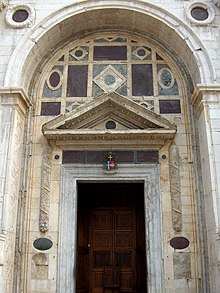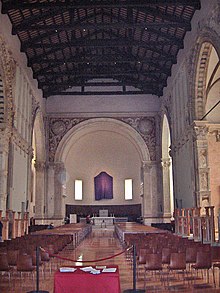
Rimini is a city in the Emilia-Romagna region of Northern Italy.

Piero della Francesca was an Italian painter of the Early Renaissance. To contemporaries he was also known as a mathematician and geometer. Nowadays Piero della Francesca is chiefly appreciated for his art. His painting is characterized by its serene humanism, its use of geometric forms and perspective. His most famous work is the cycle of frescoes The History of the True Cross in the church of San Francesco in the Tuscan town of Arezzo.

Santa Maria Novella is a church in Florence, Italy, situated opposite, and lending its name to, the city's main railway station. Chronologically, it is the first great basilica in Florence, and is the city's principal Dominican church.

Fano is a town and comune of the province of Pesaro and Urbino in the Marche region of Italy. It is a beach resort 12 kilometres southeast of Pesaro, located where the Via Flaminia reaches the Adriatic Sea. It is the third city in the region by population after Ancona and Pesaro.

Sigismondo Pandolfo Malatesta was an Italian condottiero and nobleman, a member of the House of Malatesta and lord of Rimini and Fano from 1432. He was widely considered by his contemporaries as one of the most daring military leaders in Italy and commanded the Venetian forces in the 1465 campaign against the Ottoman Empire. He was also a poet and patron of the arts.

The House of Malatesta was an Italian family that ruled over Rimini from 1295 until 1500, as well as other lands and towns in Romagna and holding high positions in the government of cities in present-day Tuscany, Lombardy and Marche. The dynasty is considered among the most important and influential of the Late Middle Ages. In the period of maximum influence, they extended their domains along the Marche coast, up to Ascoli Piceno, Senigallia, Sansepolcro and Citerna, and to the north, on the territories of Bergamo and Brescia.

Agostino di Duccio was an early Renaissance Italian sculptor.
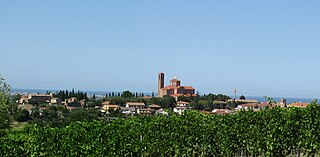
Coriano is a comune in the province of Rimini. This town is known for being the town of the Motorcycle World Champion, in 250cc class, Marco Simoncelli.

Santarcangelo di Romagna is a comune in the province of Rimini, in the Italian region of Emilia-Romagna, on the Via Emilia. As of 2009, it had a population of some 21,300. It is crossed by two rivers, the Uso and the Marecchia.

Roberto Malatesta was an Italian condottiero, or mercenary captain, lord of Rimini, and a member of the House of Malatesta.

Portrait of Princess is a tempera painting on panel attributed to the Italian Late-Gothic master Pisanello. It was probably executed between 1435 and 1445 and is also known as Portrait of a Princess of the House of Este. It is firmly attributed to Pisanello on stylistic grounds and because he stayed in Ferrara in the period, where he also finished a portrait and a celebrative medal of Marquis Leonello d'Este.
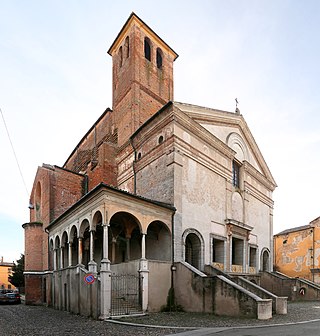
San Sebastiano is an Early Renaissance church in Mantua, northern Italy. Begun in 1460 according to the designs of Leon Battista Alberti, it was left partially completed in the mid-1470s, by which time construction had slowed and was no longer being directed by Alberti. As a consequence, little remains of Alberti’s work apart from the plan, which is considered one of the earliest and most significant examples of Renassiances centrally-planned churches. The plan is in the shape of a Greek cross, with three identical arms centering apses, under a central cross-vaulted space without any interior partitions. The church sits on a ground-level crypt which was intended to serve as a mausoleum for the Gonzaga family.

The Portrait of Sigismondo Pandolfo Malatesta is a painting attributed to the Italian Renaissance master Piero della Francesca. It portrays the condottiero and lord of Rimini and Fano Sigismondo Pandolfo Malatesta, and is housed in the Musée du Louvre of Paris.
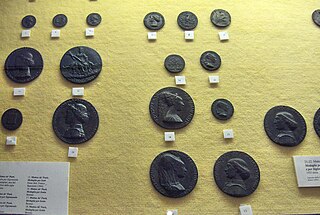
Matteo di Andrea de' Pasti (1420-1467/1468) was an Italian sculptor and medalist.
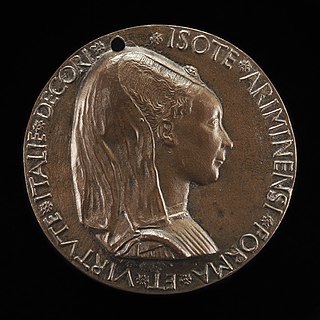
Isotta degli Atti was an Italian Renaissance woman and regent. She was the mistress and later wife of the condottiero and lord of Rimini, Sigismondo Pandolfo Malatesta. She governed Rimini as regent during the excommunication of Malatesta in 1460-62, as well as during the minority of their son in 1468–69.

The Portrait of Sigismund of Luxembourg is a tempera on panel painting attributed to the Italian Late-Gothic master Pisanello and probably executed between 1432 and 1433. It is on display at the Kunsthistorisches Museum in Vienna, Austria.

Ginevra d'Este was an Italian noblewoman. She and her twin sister Lucia were daughters of Niccolò III d'Este and his second wife Parisina Malatesta - they also had a younger brother, who died aged a few months. She was the first of Sigismondo Pandolfo Malatesta's three wives.
The following is a timeline of the history of the city of Rimini in the Emilia-Romagna region of Italy.

Sallustio Malatesta was an Italian noble. He was the son of Sigismondo Pandolfo Malatesta, lord of Rimini, and Isotta degli Atti. At first, Isotta was Sigismondo's mistress, but after the death of his wife Polissena Sforza, they would marry.
Polissena Sforza was an Italian noblewoman and wife of the Lord of Rimini. She was the daughter of the condottiero Francesco Sforza, the future Duke of Milan, and Giovanna d'Acquapendente, his mistress, with whom he had five children.

